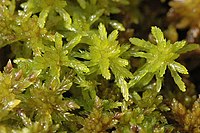
Photo from wikipedia
Abstract We conducted a modern process study on Sphagnum magellanicum from southern Patagonian peat bogs to improve our understanding of environmental controls on the carbon and water (hydrogen and oxygen)… Click to show full abstract
Abstract We conducted a modern process study on Sphagnum magellanicum from southern Patagonian peat bogs to improve our understanding of environmental controls on the carbon and water (hydrogen and oxygen) isotope compositions of peat mosses. We found that moisture availability gradients in peat bogs, measured by Sphagnum water content, could explain the intra-site variability in both Sphagnum cellulose δ13C and δ18O. Also, there was a site-specific significant negative correlation between cellulose δ13C and δ18O across microtopographical gradient. This new finding suggests that Sphagnum moisture availability influences cellulose δ13C via water film effect on discrimination against 13CO2 and, similarly, can imprint on cellulose δ18O via evaporative enrichment of 18O in metabolic leaf water. Sphagnum leaf wax n-alkane δ13C also responded to the water film effect as cellulose did, but n-alkane δ2H appears less sensitive than cellulose δ18O to the moisture availability gradient likely because hydrogen isotopes have a more complex biochemical fractionation pathway and a smaller kinetic fractionation during leaf water evaporation. Furthermore, we used long strands of Sphagnum to explore if isotopic signals in moss strand increments were sensitive to recent growing season conditions. We demonstrated that rapidly growing Sphagnum strand increments could document the isotopic composition of precipitation and moisture conditions at sub-annual scale. Altogether, these findings highlight the sensitivity of stable isotopes in Sphagnum to environmental conditions. On the basis of these results, we propose that paired measurements of carbon and water isotopes in Sphagnum cellulose or leaf wax biomarker provide an improved approach in peat-based paleoclimate reconstructions.
Journal Title: Geochimica et Cosmochimica Acta
Year Published: 2020
Link to full text (if available)
Share on Social Media: Sign Up to like & get
recommendations!